Analyzing Positional Contributions in Bayer Leverkusen’s Unbeaten Season with VAEP
Exploring How Leverkusen’s Positional Units Shaped their Success
Introduction to VAEP and Bayer Leverkusen’s Unbeaten Season
Modern football analytics owes much to groundbreaking frameworks like Valuing Actions by Estimating Probabilities (VAEP). Developed by researchers at KU Leuven, VAEP has revolutionized the way we understand player contributions by evaluating every on-ball action’s impact on a team’s likelihood of scoring or conceding. This approach goes beyond goals and assists, shining a light on the often-overlooked moments that define matches and seasons. I extend my gratitude to the creators of VAEP for providing the tools to delve deeper into the intricacies of football performance.
For Bayer Leverkusen, VAEP offers a unique lens to analyze their extraordinary unbeaten campaign during the 2023/2024 Bundesliga season. Leverkusen didn’t just avoid defeat—they dominated matches, salvaged critical points, and epitomized resilience. Remarkably, this analysis doesn’t even include a loss category, underscoring the rarity of their accomplishment. Adding to their mystique, Leverkusen boasted a knack for scoring late, earning the nickname “Neverkusen.” A staggering 17 of their 86 league goals were scored after the 80th minute, exemplifying their ability to deliver in high-pressure situations (courtesy StatsBomb event data).
In this analysis, I focus on data from the Bundesliga season provided by StatsBomb, categorizing matches into three result types: Comfortable Wins, Close Wins, and Late Equalizer Draws. The matches under consideration are:
Comfortable Wins
- April 14, 2024: Bayer Leverkusen 5-0 Werder Bremen
- November 12, 2023: Bayer Leverkusen 4-0 Union Berlin
- February 10, 2024: Bayer Leverkusen 3-0 Bayern Munich
Close Wins
- November 4, 2023: Hoffenheim 2-3 Bayer Leverkusen
- January 20, 2024: RB Leipzig 2-3 Bayer Leverkusen
- August 19, 2023: Bayer Leverkusen 3-2 RB Leipzig
Late Equalizer Draws
- September 15, 2023: Bayern Munich 2-2 Bayer Leverkusen
- April 27, 2024: Bayer Leverkusen 2-2 VfB Stuttgart
- April 21, 2024: Borussia Dortmund 1-1 Bayer Leverkusen
Goals of the Analysis
The objective of this analysis is to uncover the patterns and dynamics behind Leverkusen’s unbeaten run. Specifically, I aim to:
- Understand positional contributions: Evaluate how attackers, midfielders, defenders, and goalkeepers influenced outcomes across three result types.
- Analyze temporal dynamics: Use cumulative VAEP line charts to examine how contributions evolved over the course of individual matches.
- Compare positional trends: Leverage strip plots to assess the final cumulative VAEP contributions of each position category. These plots provide a comparative overview of positional influence, highlighting patterns of consistency or variability in contributions across selected matches.
By integrating cumulative VAEP line charts and strip plots, we can delve into the interplay between positional dynamics and match contexts, offering insights into how Leverkusen consistently adapted to diverse scenarios.
Sustaining the Unbeaten Run: Match-by-Match Analysis
Let’s first look at temporal dynamics within matches using cumulative VAEP line charts. Through these charts, I am hoping to see how positional contributions evolved over the course of each match, shedding light on the moments and players that defined Bayer Leverkusen’s unbeaten campaign. For Bayer Leverkusen, these charts illustrate how defenders, midfielders, attackers, and goalkeepers influenced the flow of games, with their contributions represented in distinct colors—yellow for goalkeepers, green for defenders, blue for midfielders, and red for attackers. Each subplot captures the VAEP contributions for both Bayer Leverkusen and their opponents, with dashed vertical lines marking the timing of goals scored by each team. These elements together offer a clear, intuitive way to interpret the ebb and flow of matches, pinpointing key moments that defined Leverkusen’s unbeaten campaign.
Comfortable Wins
Bayer Leverkusen 5-0 Werder Bremen (April 14, 2024)
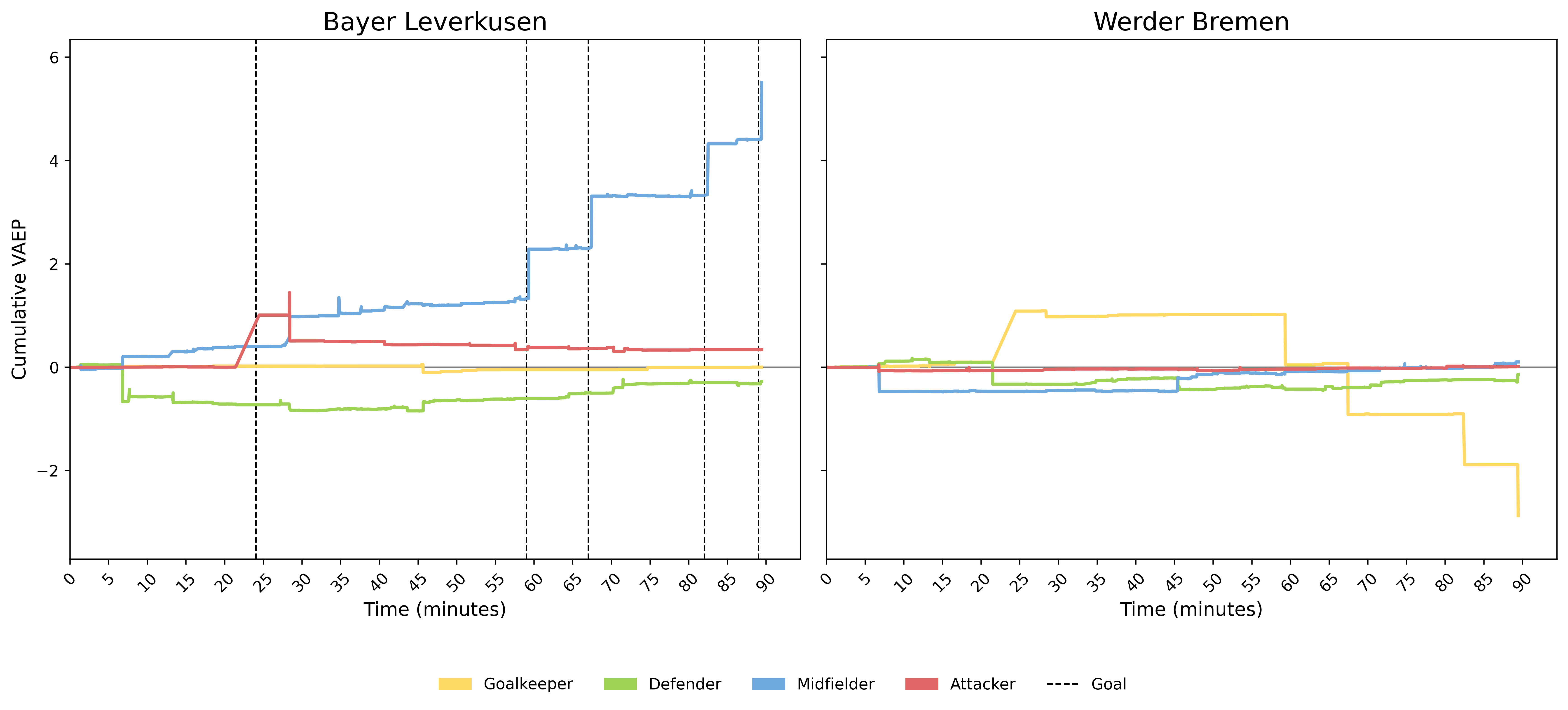
Leverkusen’s midfielders orchestrated a commanding victory, contributing a cumulative 5.50 VAEP, as reflected in sharp spikes during the second half. These contributions aligned with Florian Wirtz’s hat-trick between the 68th and 90th minutes, demonstrating the midfield’s ability to create and execute decisive plays. Granit Xhaka’s goal in the 60th minute further showcased the midfield’s dominance. While Boniface’s penalty in the 25th minute highlighted an early attacking contribution, defenders ended with -0.27 VAEP, reflecting their limited involvement in attacking phases. The goalkeeper remained neutral, with little to do throughout the game.
Bayer Leverkusen 4-0 Union Berlin (November 12, 2023)
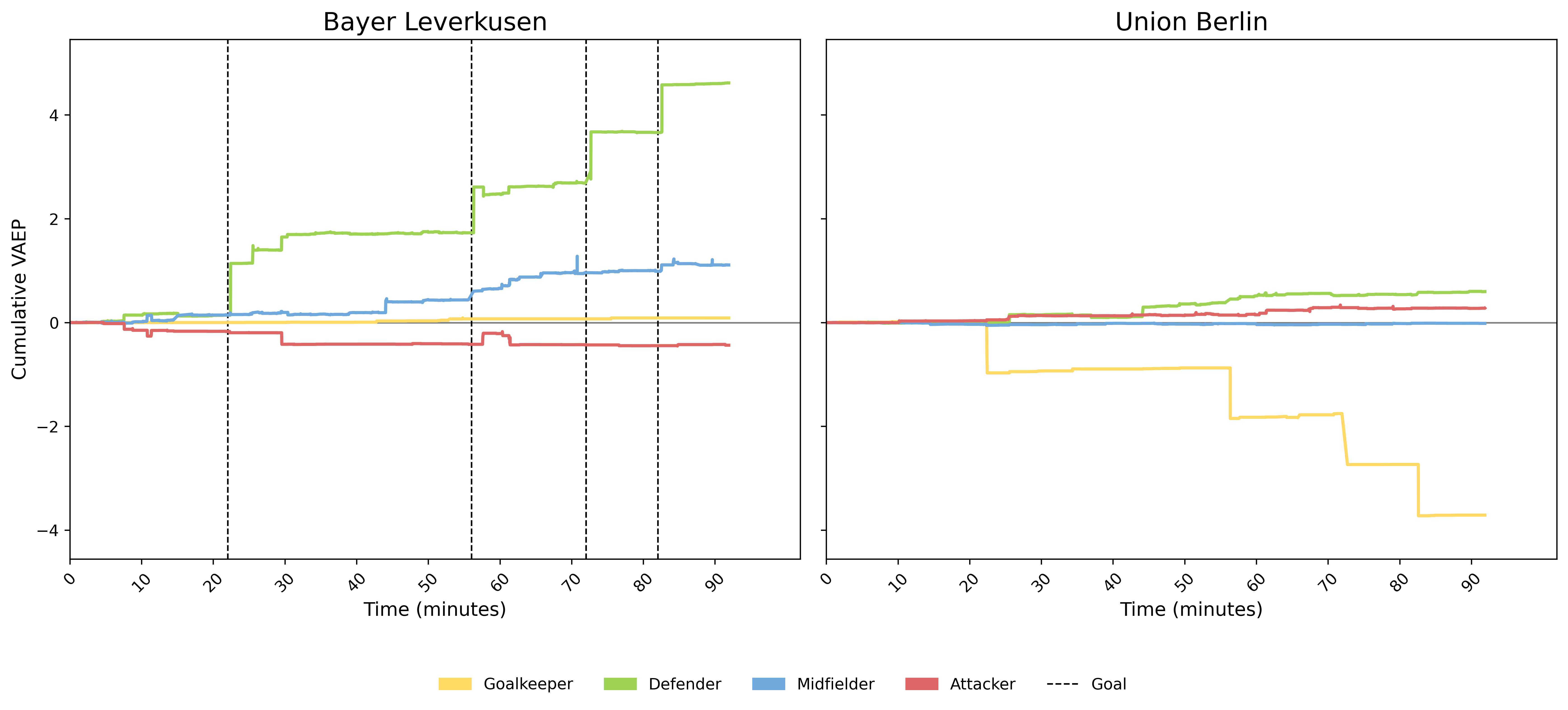
This victory was a showcase for Leverkusen’s defenders, who amassed a cumulative 4.62 VAEP. Remarkably, three of the four goals came from defenders, reflecting their involvement in both offensive and defensive transitions. Midfielders provided steady contributions to facilitate buildup play, ensuring smooth connections across the pitch. Attackers played a minimal role, as evidenced by their muted VAEP values. The goalkeeper’s negligible contribution underscores the lack of significant opposition threats.
Bayer Leverkusen 3-0 Bayern Munich (February 10, 2024)
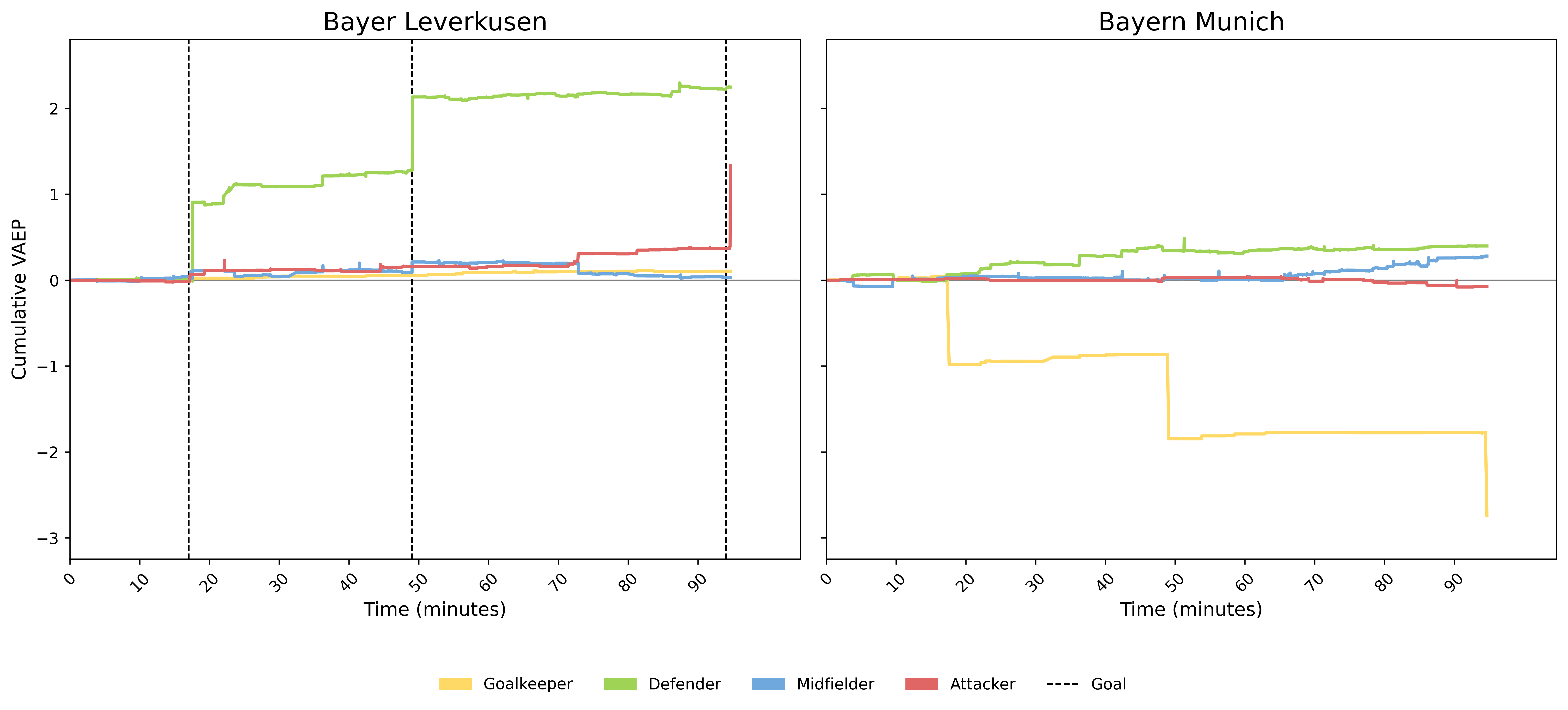
Leverkusen’s defenders were pivotal in this comprehensive win, contributing 2.25 VAEP, as all three goals—scored by Stanišić, Grimaldo, and Frimpong—originated from their ranks. This highlights the defenders’ ability to push forward and capitalize on attacking opportunities. Attackers complemented this effort with 1.34 VAEP, while midfielders provided stability and control in transitions. The goalkeeper’s limited involvement underscores the team’s dominance.
Close Wins
Hoffenheim 2-3 Bayer Leverkusen (November 4, 2023)
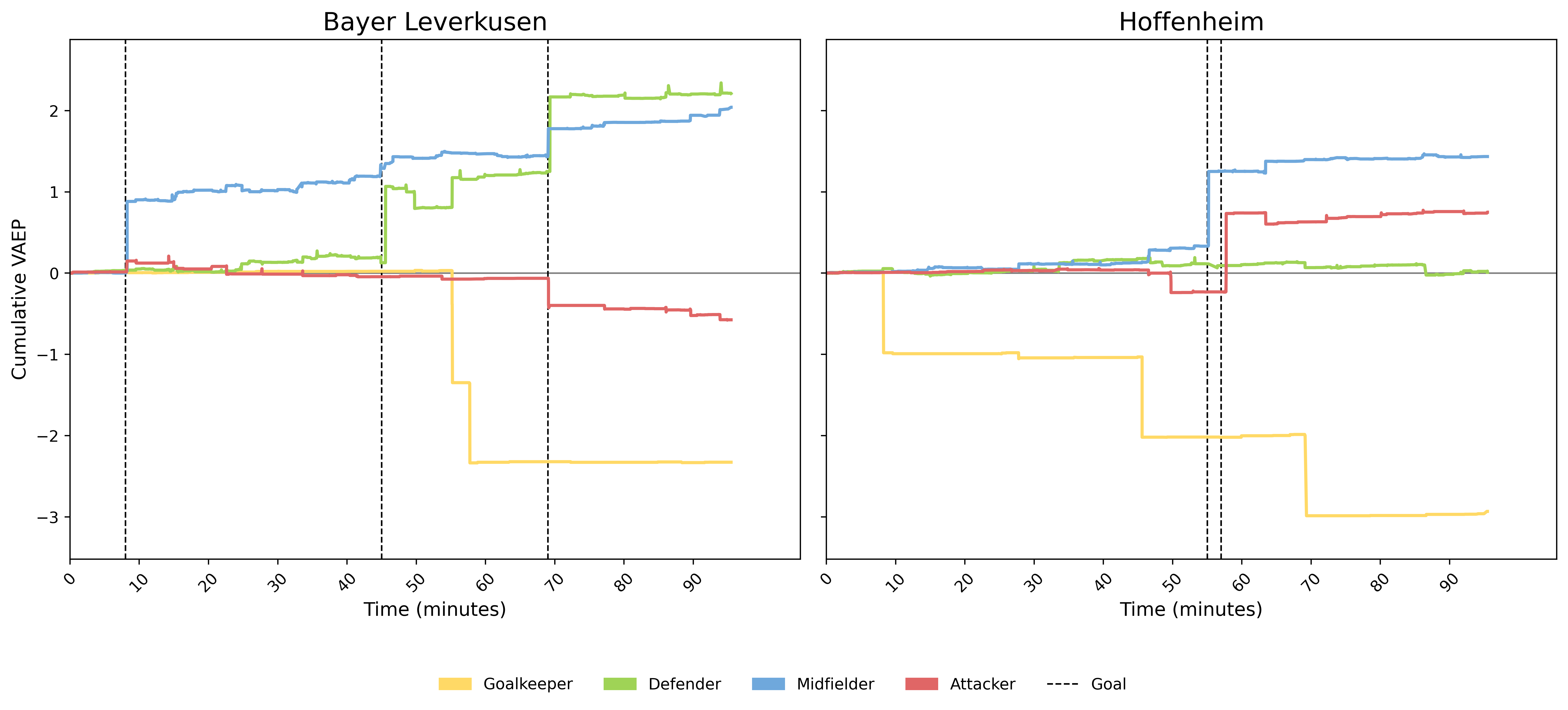
Leverkusen’s defenders and midfielders were instrumental in this high-pressure game, contributing 2.21 VAEP and 2.04 VAEP, respectively. Wirtz’s early goal in the 9th minute and Grimaldo’s strike in first-half stoppage time reflected the midfield’s influence. Defenders played a key role in maintaining stability, with Grimaldo sealing the win in the 70th minute. Attackers struggled for consistency, reflected in their -0.57 VAEP, while the goalkeeper’s -2.33 VAEP indicates challenges in dealing with Hoffenheim’s quickfire goals early in the second half.
RB Leipzig 2-3 Bayer Leverkusen (January 20, 2024)
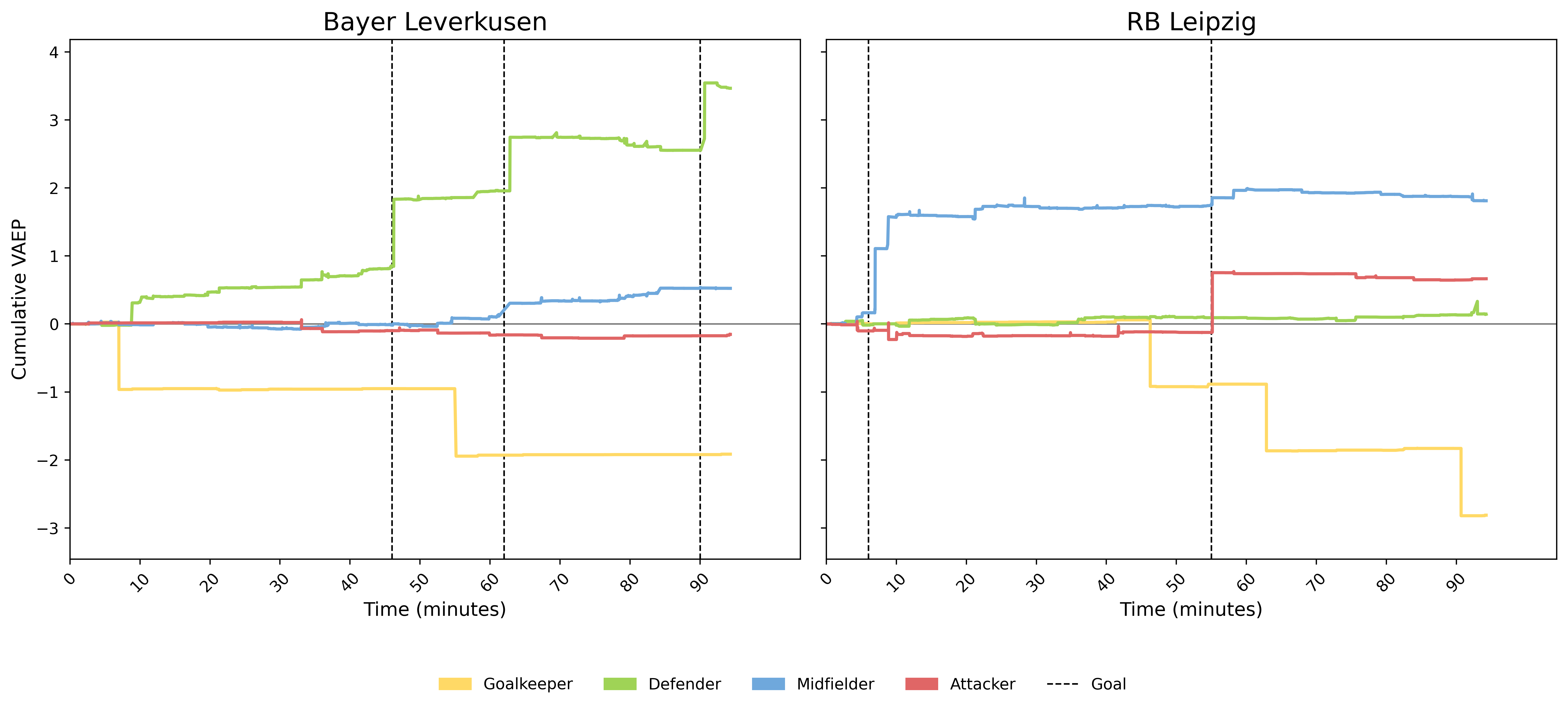
Defenders shone in this dramatic encounter, contributing a match-high 3.47 VAEP, with spikes corresponding to critical interventions and late goals. Tella’s equalizer in the 47th minute showcased the attackers’ brief involvement, while Tah and Hincapié’s goals in the 63rd and 91st minutes reflected the defenders’ decisive influence. Midfielders provided steady support with 0.52 VAEP, while the goalkeeper’s -1.91 VAEP highlights the challenges posed by Leipzig’s attacking pressure.
Bayer Leverkusen 3-2 RB Leipzig (August 19, 2023)

This closely contested match saw defenders and attackers share the spotlight. Frimpong and Tah’s early goals contributed to the defenders’ 2.06 VAEP, while Wirtz’s goal in the 64th minute punctuated the attackers’ 1.46 VAEP. Midfielders played a crucial linking role, ensuring smooth transitions between phases of play. The goalkeeper faced challenges, as reflected in their negative contributions.
Late Equalizer Draws
Bayern Munich 2-2 Bayer Leverkusen (September 15, 2023)
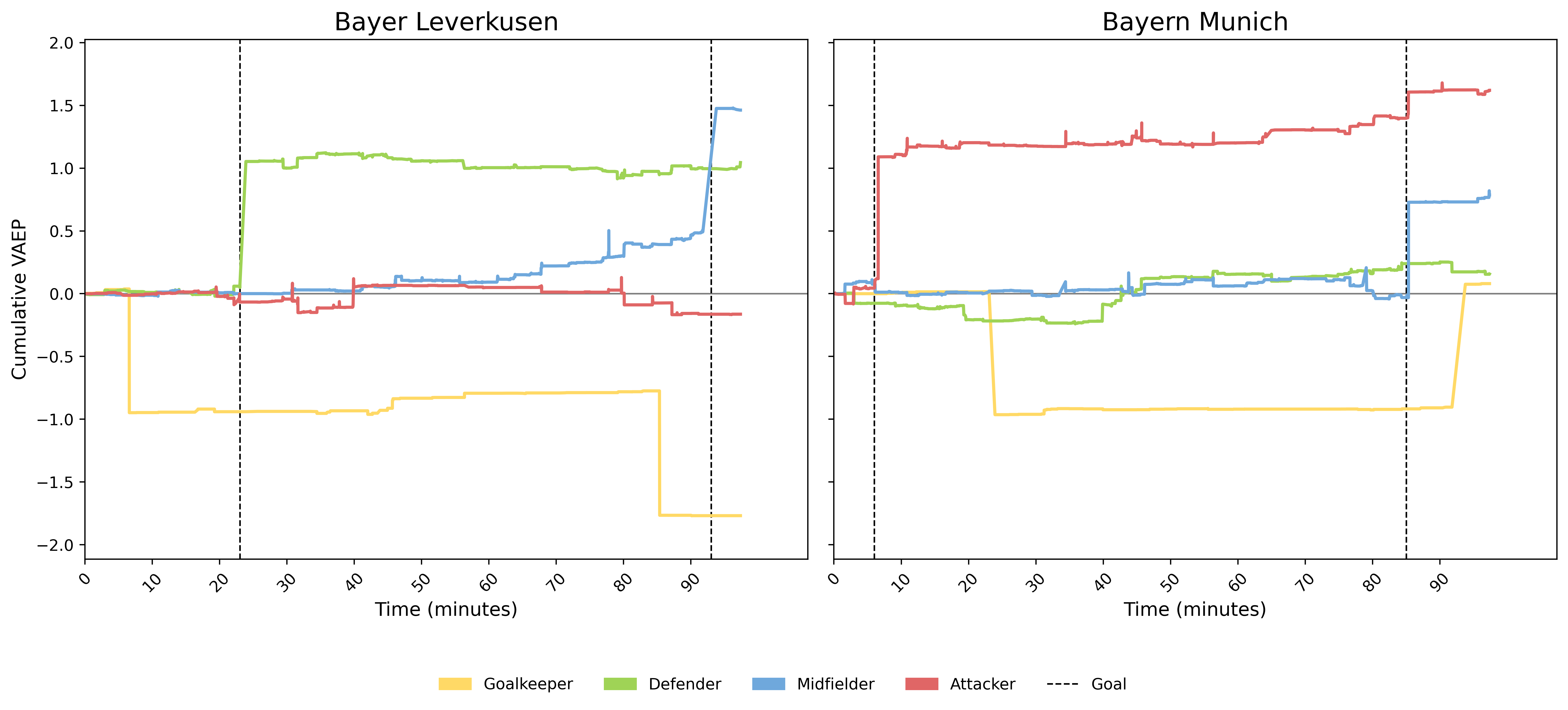
Leverkusen’s midfielders played a crucial role in salvaging this draw, contributing 1.46 VAEP, with a late spike corresponding to Palacios’ 94th-minute penalty. Defenders added 1.04 VAEP, reflecting their stabilizing influence, while the goalkeeper’s -1.77 VAEP indicates the early pressure faced, particularly from Harry Kane’s 7th-minute goal.
Borussia Dortmund 1-1 Bayer Leverkusen (April 21, 2024)

Stanišić’s stoppage-time equalizer was the defining moment in this match, reflected in the defenders’ cumulative 1.07 VAEP. The midfielders provided steady contributions (0.29 VAEP), while the goalkeeper’s -0.97 VAEP reflects early vulnerabilities that left Bayer chasing the game.
Bayer Leverkusen 2-2 VfB Stuttgart (April 27, 2024)
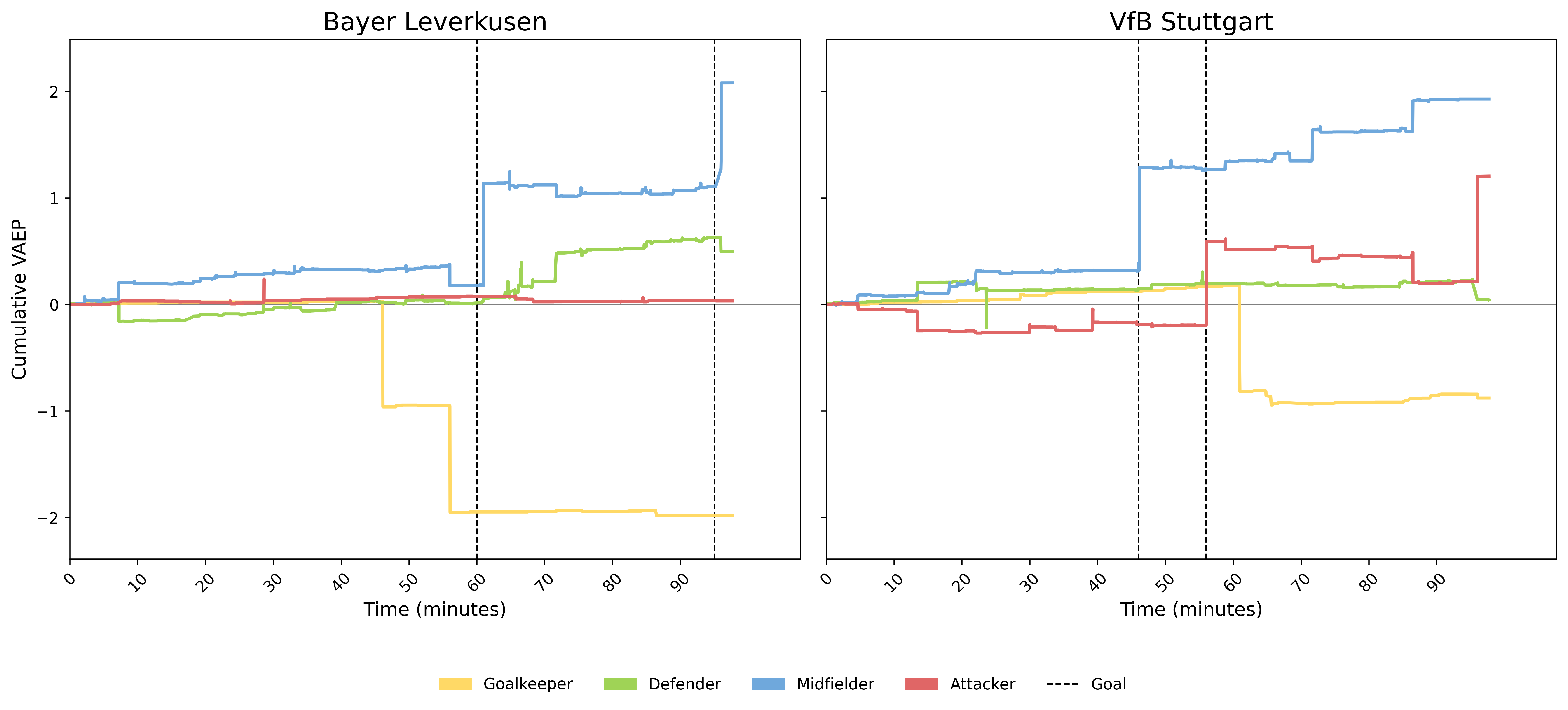
Leverkusen’s midfielders were instrumental in their late comeback, contributing 2.08 VAEP, with spikes aligning with Adli’s 61st-minute goal and Andrich’s dramatic 96th-minute equalizer. Defenders added 0.50 VAEP, providing stability during the fightback, while the goalkeeper’s -1.98 VAEP reflects Stuttgart’s strong attacking moments.
Insights on the Leipzig and Munich Games
Bayer Leverkusen’s contrasting results against Bayern Munich and RB Leipzig underscore their adaptability and the varying roles of their positional units.
Against Bayern Munich
The two matches against Bayern highlight Leverkusen’s evolution. In the 2-2 draw, Leverkusen relied on defensive and midfield stability to recover twice, with Grimaldo’s equalizer and Palacios’ last-minute penalty. Midfielders contributed a cumulative 1.46 VAEP, while defenders added 1.04 VAEP, providing crucial stability. The goalkeeper’s -1.77 VAEP reflects the early pressure, including Kane’s opening goal.
In contrast, the 3-0 victory later in the season saw Leverkusen dominate, with defenders taking on an attacking role. Goals from Stanišić, Grimaldo, and Frimpong propelled the defenders to a 2.25 VAEP, showcasing their offensive versatility. Midfielders provided consistent support, while attackers had a secondary role. The goalkeeper’s near-neutral VAEP reflects the team’s control over Bayern’s attack.
The draw highlighted Leverkusen’s resilience, while the win demonstrated their ability to exploit Bayern’s weaknesses and control the game.
Against RB Leipzig
The narrow 3-2 wins against Leipzig home and away showcased Leverkusen’s defensive resilience and late-game decisiveness. In January, Tah and Hincapié turned the tide with late goals, driving the defenders’ 3.47 VAEP, while midfielders contributed 0.52 VAEP to sustain transitions. Attackers struggled, with -0.15 VAEP, and the goalkeeper’s -1.91 VAEP reflected Leipzig’s relentless pressure.
The August match followed a similar pattern. Early goals from Frimpong and Tah set the tone, while Wirtz’s late goal secured the win, pushing attackers to 1.46 VAEP. Defenders contributed 2.06 VAEP, excelling in both defensive duties and attacking phases. Midfielders provided the necessary balance to withstand Leipzig’s pressing.
Against Bayern, Leverkusen shifted from reactive resilience to proactive control. Against Leipzig, defensive brilliance and opportunistic play defined their success, showcasing their ability to adapt to contrasting challenges.
Comparison Across the Two Opponents
The matches against Bayern and Leipzig underscore how Leverkusen’s positional units adapted to varying demands. Against Bayern, the contrast between the draw and the win demonstrates the team’s growth: from reacting to Bayern’s threats in the earlier game to asserting dominance and exploiting defensive weaknesses in the second. Against Leipzig, Leverkusen relied heavily on defensive resilience and midfield stability to handle Leipzig’s pressing game, with defenders stepping up in both scoring and critical interventions.
These encounters showcase Leverkusen’s positional flexibility and strategic adaptability, whether turning to defenders for offensive contributions or midfielders to drive comebacks. The contrast between the controlled dominance against Bayern in the 3-0 win and the dramatic resilience in the Leipzig games encapsulates the depth and dynamism of Leverkusen’s unbeaten campaign.
From Temporal Trends to Positional Snapshots
Let’s now transition from the dynamic temporal trends captured in the cumulative VAEP line charts to a positional analysis using strip plots. These plots visualize the final cumulative VAEP values for Bayer Leverkusen’s positional categories—attackers, midfielders, defenders, and goalkeepers—segmented by result categories.
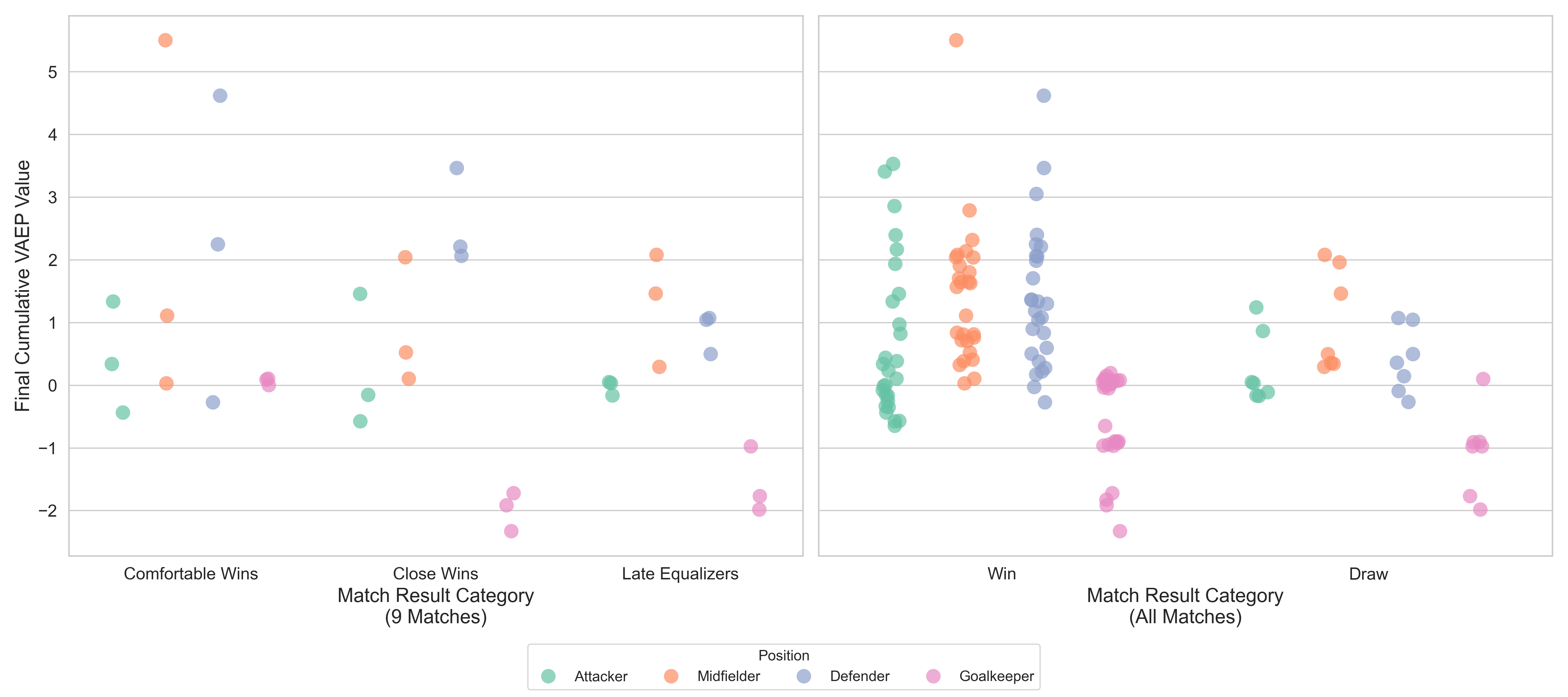
In the plot above, each point on both charts represent the cumulative VAEP value for a positional category in a specific match, the chart on the left focuses on the nine selected matches, categorized into Comfortable Wins, Close Wins, and Late Equalizer Draws. The second chart on the right expands to all matches from the Bundesliga season, categorized more broadly into Wins and Draws.
Clusters of points indicate consistency in contributions, with values tightly grouped within a specific range. In contrast, more scattered points suggest variability in contributions, reflecting a wider range of influence by a given position. While the exact placement of each point provides granular insights, the broader patterns visible in these plots offer an intuitive understanding of how positional units shaped Leverkusen’s performances across different match contexts. By visualizing these contributions, the strip plots emphasize the interplay of roles that underpinned Leverkusen’s unbeaten campaign.
Insights from the Nine Selected Matches
In the nine selected matches, the strip plot reveals clear patterns in positional contributions:
-
Midfielders consistently delivered significant contributions, particularly in Comfortable Wins, where they recorded some of the highest VAEP values, such as 5.50 in the 5-0 win over Werder Bremen. In Close Wins and Late Equalizer Draws, their values were slightly lower but still impactful, such as 2.04 in the 3-2 win over Hoffenheim and 2.08 in the 2-2 draw vs. Stuttgart.
-
Defenders showed a dual role. In Comfortable Wins, they contributed both defensively and offensively, with notable peaks like 4.62 in the 4-0 win vs. Union Berlin. In Close Wins, they were decisive in tight moments, contributing values such as 3.47 in the 3-2 win away at Leipzig. Even in Late Equalizer Draws, they provided stability, such as 1.07 in the 1-1 draw against Dortmund.
-
Attackers demonstrated variability. Their contributions peaked in Comfortable Wins, such as 1.34 in the famous 3-0 win vs. Bayern Munich, but were less consistent in Close Wins and Late Equalizer Draws, with values such as -0.57 in the narrow 3-2 win against Hoffenheim and near-neutral values in some draws.
-
Goalkeepers had limited involvement in Comfortable Wins, with near-zero VAEP values reflecting the lack of defensive challenges. In contrast, they faced significant pressure in Close Wins and Late Equalizer Draws, with consistently negative VAEP values, such as -1.91 in the tightly contested 3-2 win away at Leipzig and -1.77 in the dramatic late equalizer in the 2-2 draw vs. Bayern early in the season.
Comparing All Matches with the Nine Matches
Expanding the analysis to all matches in the season, the strip plot highlights several similarities and differences:
-
Midfielders remained the most consistent contributors across both datasets. While their contributions in selected matches showed sharper peaks (e.g., 5.50 in Comfortable Wins), their values across all matches were more evenly distributed, reflecting their steady influence throughout the season.
-
Defenders continued to play a pivotal role in both datasets. However, their values across all matches revealed less dramatic peaks, suggesting that their standout contributions in the nine matches were more context-dependent (e.g., tight games or dominant wins).
-
Attackers showed slightly higher variability in all matches compared to the selected ones, with occasional peaks. This underscores their reliance on specific match contexts to shine.
-
Goalkeepers maintained a similar trend across both datasets, with minimal contributions in Wins and negative values in Draws. This reflects their limited role in dominant performances and the challenges of facing opposition pressure in tighter games.
Key Takeaways from the Strip Plots
The strip plots provide a comprehensive view of positional contributions. While the nine selected matches showcased the positional units’ ability to adapt to specific match contexts, the broader dataset highlights their overall consistency across a successful season. The defenders and midfielders stood out as the backbone of Leverkusen’s unbeaten campaign, while attackers and goalkeepers showed greater variability depending on the match scenario. Together, these insights underline the importance of positional flexibility and collective effort in sustaining such an extraordinary achievement.
Summary
The cumulative VAEP line charts highlight the ebb and flow of positional contributions within matches, illustrating how Bayer Leverkusen’s players adapted to different game states. Midfielders consistently stood out as the most influential unit, bridging defense and attack while anchoring the team’s performance across match contexts. Their ability to control games in comfortable wins and drive comebacks in draws underscores their versatility and reliability. Defenders complemented this stability, demonstrating both offensive and defensive prowess. Peaks in their VAEP values reflect decisive contributions in critical moments, particularly in close wins and late equalizer draws, where their influence often proved pivotal.
The strip plots provide a broader perspective by comparing positional contributions across all matches and the nine selected games categorized by result type. In both datasets, midfielders remained the most consistent performers, while defenders showed adaptability with significant attacking contributions in comfortable wins and stability in tighter matches. Attackers, though impactful in comfortable wins, displayed more variability, emphasizing their dependence on opportunities created by other positions. Goalkeepers faced minimal demands in dominant wins but were tested under pressure in close wins and draws, with their negative VAEP values reflecting the challenges of conceding goals. Together, these insights reveal the collective effort and positional flexibility that defined Leverkusen’s unbeaten season.
